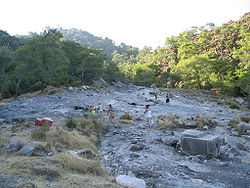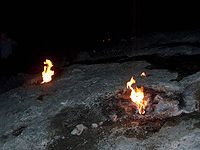
Chimaera (geography)
Encyclopedia

Lycia
Lycia Lycian: Trm̃mis; ) was a region in Anatolia in what are now the provinces of Antalya and Muğla on the southern coast of Turkey. It was a federation of ancient cities in the region and later a province of the Roman Empire...
, notable for volcanic phenomena and said by some ancient sources to be the origin of the myth of the Chimera
Chimera (mythology)
The Chimera or Chimaera was, according to Greek mythology, a monstrous fire-breathing female creature of Lycia in Asia Minor, composed of the parts of multiple animals: upon the body of a lioness with a tail that ended in a snake's head, the head of a goat arose on her back at the center of her...
.
Ctesias
Ctesias
Ctesias of Cnidus was a Greek physician and historian from Cnidus in Caria. Ctesias, who lived in the 5th century BC, was physician to Artaxerxes Mnemon, whom he accompanied in 401 BC on his expedition against his brother Cyrus the Younger....
is the oldest traceable author to offer this euhemerizing theory. This was the citation given by Pliny the Elder
Pliny the Elder
Gaius Plinius Secundus , better known as Pliny the Elder, was a Roman author, naturalist, and natural philosopher, as well as naval and army commander of the early Roman Empire, and personal friend of the emperor Vespasian...
, who in his second book of Historia Naturalis
Historia Naturalis
Historia Naturalis may refer to:*Natural History , a natural history encyclopedia by Pliny the Elder*Historia naturalis palmarum, a botanical book by Carl Friedrich Philipp von Martius published between 1823 and 1850...
identified the Chimaera with the permanent gas vents in Mount Chimera, in the country of the ancient Lycian city of Phaselis
Phaselis
Phaselis is an ancient Lycian city in the province of Antalya in Turkey. It is located between the Bey Mountains and the forests of Olympos National Park, 16 km west of the touristic town of Kemer and on the 57th kilometre of the Antalya–Kumluca highway...
, which he described as being "on fire", adding that it "...indeed burned with a flame that does not die by day or night". Pliny was quoted by Photius and Agricola
Agricola
-People:*Agricola , Western Roman statesman*Agricola , son of the Western Roman Emperor Avitus*Saints Vitalis and Agricola , martyrs*Saint Agricola of Avignon , bishop of Avignon...
, although the exact location of the mountain described by Strabo is still open to debate.
Strabo and Pliny are the only surviving ancient sources who would be expected to discuss a Lycian toponym, but the placename is also attested by Isidore of Seville
Isidore of Seville
Saint Isidore of Seville served as Archbishop of Seville for more than three decades and is considered, as the historian Montalembert put it in an oft-quoted phrase, "le dernier savant du monde ancien"...
and Servius, the commentator on the Aeneid
Aeneid
The Aeneid is a Latin epic poem, written by Virgil between 29 and 19 BC, that tells the legendary story of Aeneas, a Trojan who travelled to Italy, where he became the ancestor of the Romans. It is composed of roughly 10,000 lines in dactylic hexameter...
. Strabo
Strabo
Strabo, also written Strabon was a Greek historian, geographer and philosopher.-Life:Strabo was born to an affluent family from Amaseia in Pontus , a city which he said was situated the approximate equivalent of 75 km from the Black Sea...
held the Chimaera to be a ravine on a different mountain in Lycia, placing it unhesitatingly in the vicinity of the Cragus Mountains, southern part of the present Babadağ, some 75 km. due west as the crow flies, and Isidore quotes writers on natural history (see below) that Mount Chimaera was on fire here, had lions and goats there, and was full of snakes over there. Servius goes so far as to arrange these with the lions on the peak of the mountain, pastures full of goats in the middle, and serpents all about the base, thus imitating Homer
Homer
In the Western classical tradition Homer , is the author of the Iliad and the Odyssey, and is revered as the greatest ancient Greek epic poet. These epics lie at the beginning of the Western canon of literature, and have had an enormous influence on the history of literature.When he lived is...
's description of the monster
Chimera (mythology)
The Chimera or Chimaera was, according to Greek mythology, a monstrous fire-breathing female creature of Lycia in Asia Minor, composed of the parts of multiple animals: upon the body of a lioness with a tail that ended in a snake's head, the head of a goat arose on her back at the center of her...
.
The site was identified by Sir Francis Beaufort
Francis Beaufort
Rear-Admiral Sir Francis Beaufort, FRS, FRGS was an Irish hydrographer and officer in Britain's Royal Navy...
in 1811, as the modern Turkish Yanar or Yanartaş
Yanartas
Yanartaş is the Turkish name of a geographical feature near the Olympos valley and national park in Antalya Province in southwestern Turkey. The location is 80km southwest of Antalya, near the town of Çıralı. It is generally believed to be the ancient Mount Chimaera...
, which was described by T.A.B.Spratt in his Travels in Lycia
Lycia
Lycia Lycian: Trm̃mis; ) was a region in Anatolia in what are now the provinces of Antalya and Muğla on the southern coast of Turkey. It was a federation of ancient cities in the region and later a province of the Roman Empire...
, Milyas, and the Cibyra
Cibyra
Cibyra is a genus of moths of the family Hepalidae. There are 50 described species, found throughout Central and South America.- Species :*Cibyra assa - Mexico*Cibyra biedermanni - Brazil*Cibyra brasiliensis - Brazil...
tis, in company with the late Rev. E. T. Daniell. The discussion on the connection between the myth and the exact location of Mount Chimera was started by Forbiger in 1844, and the George E. Bean was of the opinion that the name was allochtonous and could have been transferred here from its original location further west, as cited by Strabo, owing to the presence of the same phenomenon and the fires.

Testimonia
- Fingunt et Chimaeram triformem bestiam; ore leono, postremis partibus draco, media caprea. Quam quidam Physiologi non animal, sed Ciliciae montem esse aiunt, quibusdam locis leones and capreas nutrientem, quibusdam ardentem, quibusdam plenum serpentibus. Hunc Bellorophontes habitabilem fecit, unde Chimaeram dicitur occidisse. Isidore of SevilleIsidore of SevilleSaint Isidore of Seville served as Archbishop of Seville for more than three decades and is considered, as the historian Montalembert put it in an oft-quoted phrase, "le dernier savant du monde ancien"...
, Etymologiae 11.3.36- The Chimera is depicted as a three-formed beast; a lion in front, a python in its hinder parts, goatlike in the middle. Certain writers on natural history say it isn't an animal, but a mountain in Cilicia, which in some places feeds lions and goats, in some burns, in some is full of snakes. BellerophonBellerophonBellerophon or Bellerophontes is a hero of Greek mythology. He was "the greatest hero and slayer of monsters, alongside of Cadmus and Perseus, before the days of Heracles", and his greatest feat was killing the Chimera, a monster that Homer depicted with a lion's head, a goat's body, and a...
made this habitable, whence he is said to have "killed Chimaera".- Isidore unetymologically connected Lycia and Cilicia, as below.
- The Chimera is depicted as a three-formed beast; a lion in front, a python in its hinder parts, goatlike in the middle. Certain writers on natural history say it isn't an animal, but a mountain in Cilicia, which in some places feeds lions and goats, in some burns, in some is full of snakes. Bellerophon
- Lycia nuncupata quod ab oriente adjuncta Ciliciae sit. Nam habet ab ortû Ciliciam, ab occasû et meridie mare, a septentrione Cariam. Ibi est mons Chimaera, qui noctibus aestibus ignem exhalat: sicut in Siciliâ Aetna et Vesuvius in Campaniâ. Isidore of SevilleIsidore of SevilleSaint Isidore of Seville served as Archbishop of Seville for more than three decades and is considered, as the historian Montalembert put it in an oft-quoted phrase, "le dernier savant du monde ancien"...
, Etymologies 14,3,46.- There [in Lycia] is Mount Chimaera, which breathes out fire on summer nights, like Etna in Sicily and Vesuvius in Campania.
- Pliny 2.105 Mayhoff
- Mount Chimaera (English)
- Pliny 5.43
- Mount Chimaera (English}
- Pliny 5.53
- Chimaera as a geographical reference point. (English)
- "Cape" is a glossGlossA gloss is a brief notation of the meaning of a word or wording in a text. It may be in the language of the text, or in the reader's language if that is different....
of the translator.
- "Cape" is a gloss
- Perseus's English version of Pliny differs in chapter numbering; these become 2.110, 5.28, 5.35 resp.
- Chimaera as a geographical reference point. (English)
- Servius on Aeneid 6.288.
- "In fact, there is a Mount Chimaera..."
- Strabo 14.3.5,"a certain ravine, Chimaera, stretching up from the coast." ( English)
- Near Adratchan, not far from the ruins of Olympus, a number of rounded serpentine hills rise among the limestone, and some of them bear up masses of that rock. At the junction of one of these masses of scaglia with the serpentine, is the Yanar, famous as the Chimæra of the ancients, rediscovered in modern times by Captain Beaufort. It is nothing more than a stream of inflammable gas issuing from a cavern, such as is seen in several places among the ApenninesApennine mountainsThe Apennines or Apennine Mountains or Greek oros but just as often used alone as a noun. The ancient Greeks and Romans typically but not always used "mountain" in the singular to mean one or a range; thus, "the Apennine mountain" refers to the entire chain and is translated "the Apennine...
. The serpentine immediately around the flame is burnt and ashy, but this is only for a foot or two, the immediate neighborhood of the Yanar presenting the same aspect as it wore in the days of Seneca, who writes "Laeta itaque regio est et herbida, nil flammis adurentibus" Letters 79,3 Such is the Chimæra deprived of all its terrors. It is still, however, visited as a lion by both Greeks and Turks, who make use of its classic flames to cook kebabKebabKebab is a wide variety of meat dishes originating in Middle East and later on adopted by the Middle East, and Asia Minor, and now found worldwide. In English, kebab with no qualification generally refers more specifically to shish kebab served on the skewer...
s for their dinners. (London, 1847) Vol. II, p.181-2 - In Lycia regio notissima est (Hephaestion incolae vocant), foratum pluribus locis solum, quod sine ullo nascentium damno ignis innoxius circumit. Laeta itaque regio est et herbida, nihil flammis adurentibus sed tantum vi remissa ac languida refulgentibus. Seneca Epistles 79, 3

